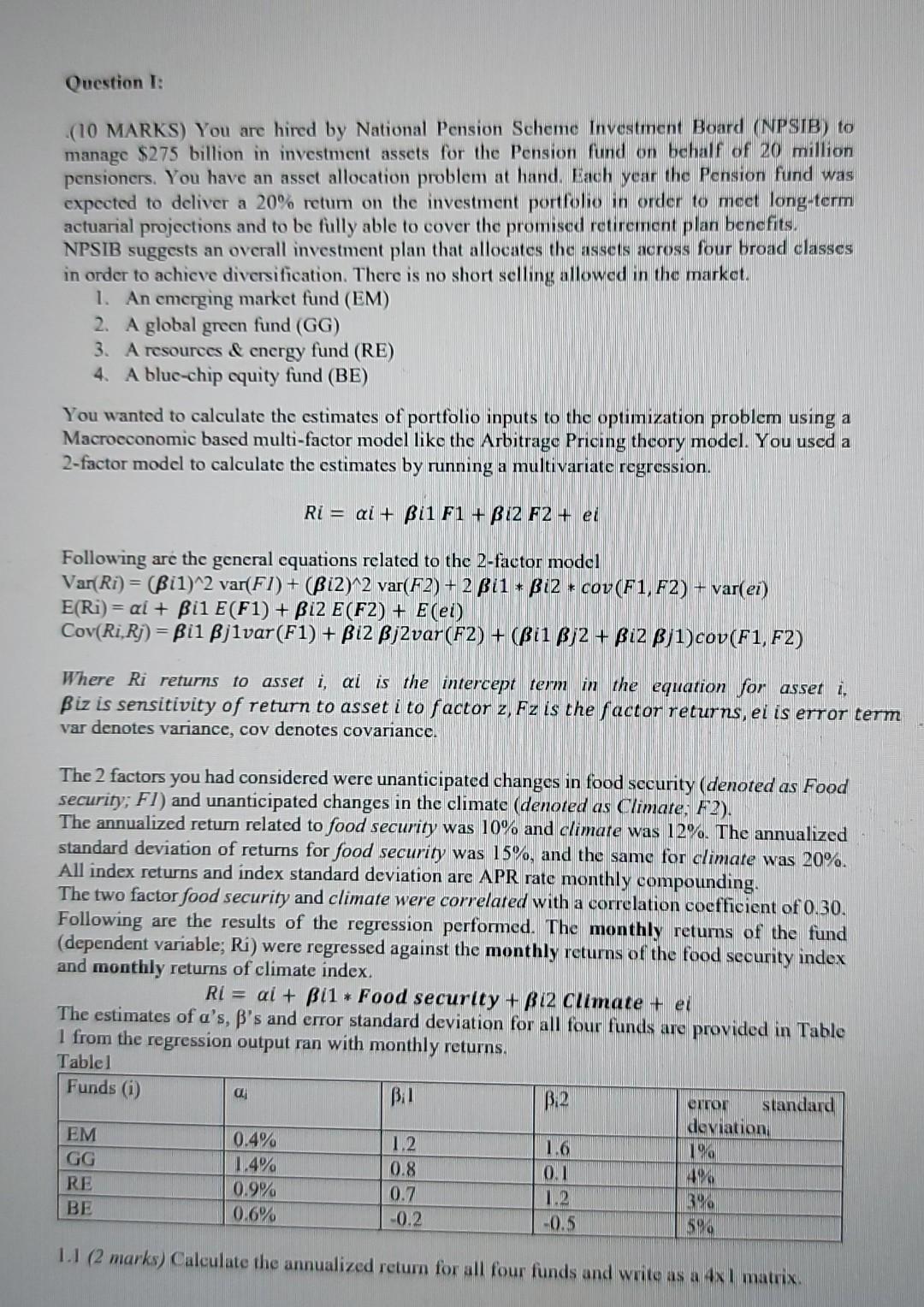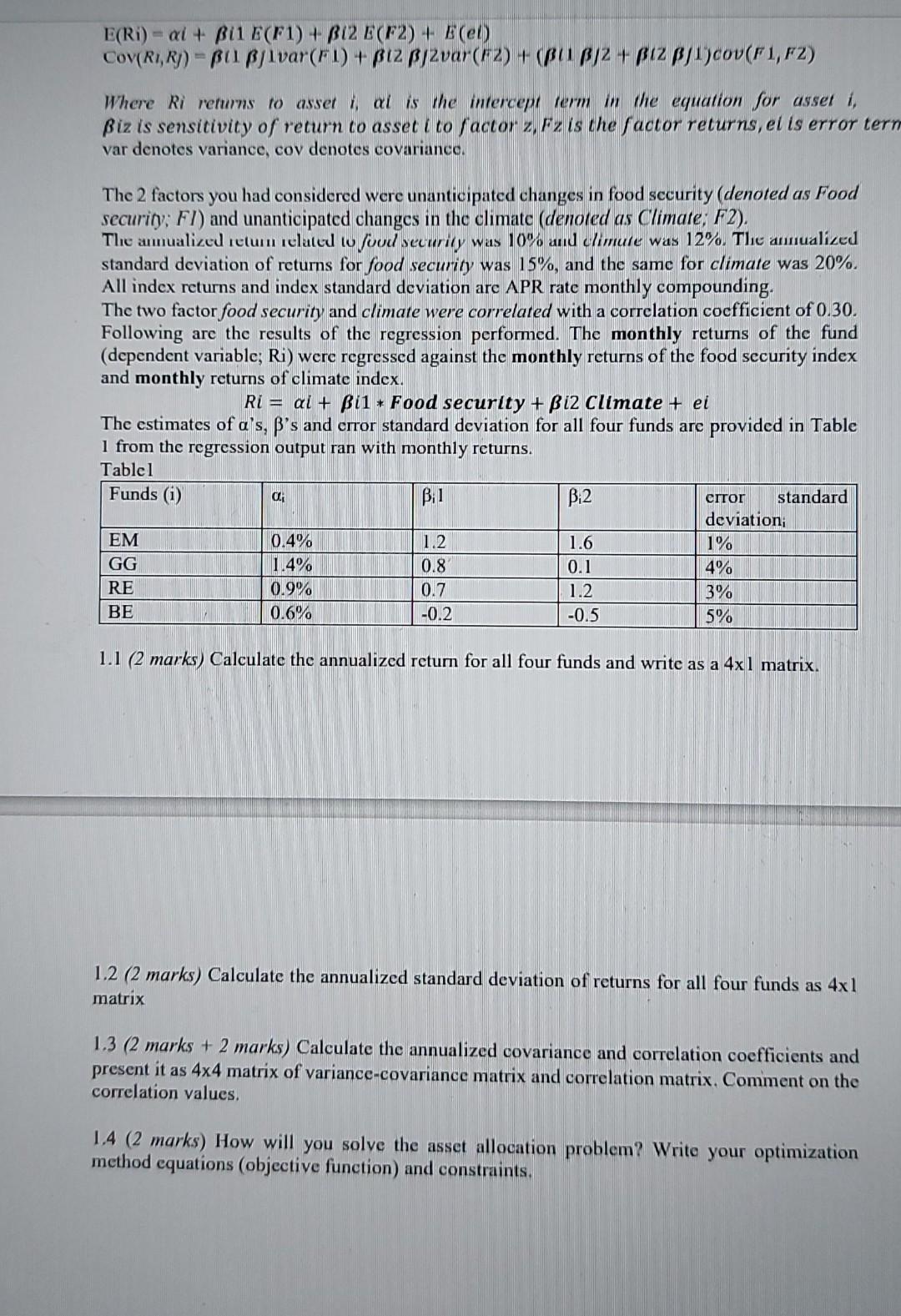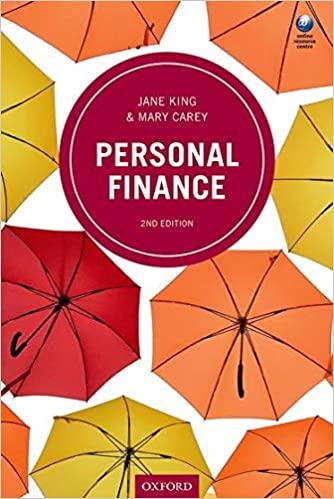Answered step by step
Verified Expert Solution
Question
1 Approved Answer
please help me solve this question Question I: (10 MARKS) You are hired by National Pension Scheme Investment Board (NPSIB) to manage $275 billion in


please help me solve this question
Question I: (10 MARKS) You are hired by National Pension Scheme Investment Board (NPSIB) to manage $275 billion in investment assets for the Pension fund on bchalf of 20 million pensioners. You have an asset allocation problem at hand. Each year the Pension fund was expected to deliver a 20% return on the investment portfolio in order to mect long-term actuarial projections and to be fully able to cover the promised retirement plan benefits. NPSIB suggests an overall investment plan that allocates the assets across four broad classes in order to achicve diversification. There is no short selling allowed in the market. 1. An emerging market fund (EM) 2. A global green fund (GG) 3. A resources \& energy fund (RE) 4. A bluc-chip cquity fund (BE) You wanted to calculate the cstimates of portfolio inputs to the optimization problem using a Macrocconomic based multi-factor model like the Arbitrage Pricing theory model. You used a 2 -factor model to calculate the cstimates by running a multivariate regression. Ri=i+i1F1+i2F2+ei Following are the general equations related to the 2-factor model Var(Ri)=(i)2var(FI)+(i2)2var(F2)+2i1i2cov(F1,F2)+var(ei)E(Ri)=i+i1E(F1)+i2E(F2)+E(ei)Cov(Ri,Rj)=i1j1var(F1)+i2j2var(F2)+(i1j2+i2j1)cov(F1,F2) Where Ri returns to asset i,i is the intercept term in the equation for asset i, iz is sensitivity of return to asset i to factor z,Fz is the factor returns, ei is error term var denotes variance, cov denotes covariance. The 2 factors you had considered were unanticipated changes in food security (denoted as Food security; F1) and unanticipated changes in the climate (denoted as Climate; F2). The annualized return related to food security was 10% and climate was 12%. The annualized standard deviation of returns for food security was 15%, and the same for climate was 20%. All index returns and index standard deviation are APR rate monthly compounding. The two factor food security and climate were correlated with a correlation coefficient of 0.30. Following are the results of the regression performed. The monthly returns of the fund (dependent variable; Ri) were regressed against the monthly returns of the food security index and monthly returns of climate index. Rl=i+i1Foodsecurlty+i2Climate+ei The estimates of 's, 's and error standard deviation for all four funds are provided in Table 1 from the regression output ran with monthly returns. Tablel 1.1 (2 marks) Calculate the annualized return for all four funds and write as a 41 matrix. E(Ri)=i+iE(F1)+i2E(F2)+E(ei) Cov(RI,R))=(1j1var(F1)+(2f2var(FZ)+((1/2+(Z)1)cov(F1,FZ) Where Ri returns to asset i,i is the intercept term in the equation for asset i, iz is sensitivity of return to asset i to factor z,Fz is the factor returns, el is error ter var denotes variance, cov denotes covariance. The 2 factors you had considered were unanticipated changes in food security (denoted as Food security; FI ) and unanticipated changes in the climate (denoted as Climate; F2). Thie ammalized ietum iclated to food security was 10% and climuie was 12%. The annualized standard deviation of returns for food security was 15%, and the same for climate was 20%. All index returns and index standard deviation are APR rate monthly compounding. The two factor food security and climate were correlated with a correlation cocfficient of 0.30. Following are the results of the regression performed. The monthly returns of the fund (dependent variable; Ri) were regressed against the monthly returns of the food security index and monthly returns of climate index. Ri=i+i1Foodsecurity+i2Climate+ei The cstimates of 's, 's and crror standard deviation for all four funds are provided in Table 1 from the regression output ran with monthly returns. 1.1 (2 marks) Calculate the annualized return for all four funds and write as a 41 matrix. 1.2 (2 marks) Calculate the annualized standard deviation of returns for all four funds as 41 matrix 1.3 (2 marks + 2 marks) Calculate the annualized covariance and correlation coefficients and present it as 44 matrix of variance-covariance matrix and correlation matrix. Comment on the correlation values. 1.4 ( 2 marks) How will you solve the asset allocation problem? Write your optimization method equations (objective function) and constraints. Question I: (10 MARKS) You are hired by National Pension Scheme Investment Board (NPSIB) to manage $275 billion in investment assets for the Pension fund on bchalf of 20 million pensioners. You have an asset allocation problem at hand. Each year the Pension fund was expected to deliver a 20% return on the investment portfolio in order to mect long-term actuarial projections and to be fully able to cover the promised retirement plan benefits. NPSIB suggests an overall investment plan that allocates the assets across four broad classes in order to achicve diversification. There is no short selling allowed in the market. 1. An emerging market fund (EM) 2. A global green fund (GG) 3. A resources \& energy fund (RE) 4. A bluc-chip cquity fund (BE) You wanted to calculate the cstimates of portfolio inputs to the optimization problem using a Macrocconomic based multi-factor model like the Arbitrage Pricing theory model. You used a 2 -factor model to calculate the cstimates by running a multivariate regression. Ri=i+i1F1+i2F2+ei Following are the general equations related to the 2-factor model Var(Ri)=(i)2var(FI)+(i2)2var(F2)+2i1i2cov(F1,F2)+var(ei)E(Ri)=i+i1E(F1)+i2E(F2)+E(ei)Cov(Ri,Rj)=i1j1var(F1)+i2j2var(F2)+(i1j2+i2j1)cov(F1,F2) Where Ri returns to asset i,i is the intercept term in the equation for asset i, iz is sensitivity of return to asset i to factor z,Fz is the factor returns, ei is error term var denotes variance, cov denotes covariance. The 2 factors you had considered were unanticipated changes in food security (denoted as Food security; F1) and unanticipated changes in the climate (denoted as Climate; F2). The annualized return related to food security was 10% and climate was 12%. The annualized standard deviation of returns for food security was 15%, and the same for climate was 20%. All index returns and index standard deviation are APR rate monthly compounding. The two factor food security and climate were correlated with a correlation coefficient of 0.30. Following are the results of the regression performed. The monthly returns of the fund (dependent variable; Ri) were regressed against the monthly returns of the food security index and monthly returns of climate index. Rl=i+i1Foodsecurlty+i2Climate+ei The estimates of 's, 's and error standard deviation for all four funds are provided in Table 1 from the regression output ran with monthly returns. Tablel 1.1 (2 marks) Calculate the annualized return for all four funds and write as a 41 matrix. E(Ri)=i+iE(F1)+i2E(F2)+E(ei) Cov(RI,R))=(1j1var(F1)+(2f2var(FZ)+((1/2+(Z)1)cov(F1,FZ) Where Ri returns to asset i,i is the intercept term in the equation for asset i, iz is sensitivity of return to asset i to factor z,Fz is the factor returns, el is error ter var denotes variance, cov denotes covariance. The 2 factors you had considered were unanticipated changes in food security (denoted as Food security; FI ) and unanticipated changes in the climate (denoted as Climate; F2). Thie ammalized ietum iclated to food security was 10% and climuie was 12%. The annualized standard deviation of returns for food security was 15%, and the same for climate was 20%. All index returns and index standard deviation are APR rate monthly compounding. The two factor food security and climate were correlated with a correlation cocfficient of 0.30. Following are the results of the regression performed. The monthly returns of the fund (dependent variable; Ri) were regressed against the monthly returns of the food security index and monthly returns of climate index. Ri=i+i1Foodsecurity+i2Climate+ei The cstimates of 's, 's and crror standard deviation for all four funds are provided in Table 1 from the regression output ran with monthly returns. 1.1 (2 marks) Calculate the annualized return for all four funds and write as a 41 matrix. 1.2 (2 marks) Calculate the annualized standard deviation of returns for all four funds as 41 matrix 1.3 (2 marks + 2 marks) Calculate the annualized covariance and correlation coefficients and present it as 44 matrix of variance-covariance matrix and correlation matrix. Comment on the correlation values. 1.4 ( 2 marks) How will you solve the asset allocation problem? Write your optimization method equations (objective function) and constraintsStep by Step Solution
There are 3 Steps involved in it
Step: 1

Get Instant Access to Expert-Tailored Solutions
See step-by-step solutions with expert insights and AI powered tools for academic success
Step: 2

Step: 3

Ace Your Homework with AI
Get the answers you need in no time with our AI-driven, step-by-step assistance
Get Started


